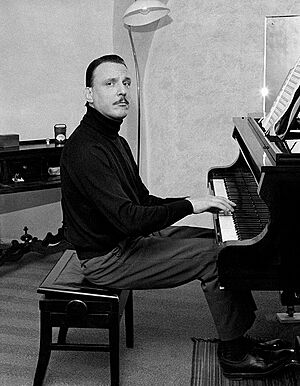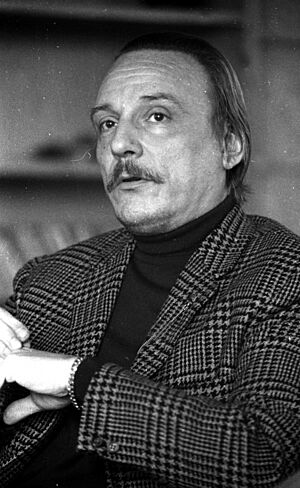Arturo Benedetti Michelangeli facts for kids
Arturo Benedetti Michelangeli (born January 5, 1920 – died June 12, 1995) was a famous Italian classical pianist. Many people think he was one of the greatest pianists of the 1900s. The New York Times newspaper said he was perhaps the most private and mysterious of the world's best pianists.
Contents
Early Life and Music Studies
Arturo Benedetti Michelangeli was born near Brescia, in Italy. He was born on January 5, 1920. His father was a lawyer and also a musician. He started teaching Arturo music before he was four years old.
Arturo first learned to play the violin at age three. Later, he studied the violin at an institute in Brescia. Then, he switched to the piano. He also studied the organ and how to compose music. When he was nine, he had private piano lessons in Milan.
At ten years old, Arturo started his formal music education. He went to the Milan Conservatory, a famous music school. He finished his studies with high honors when he was 14. Even though his parents loved music, they did not want Arturo to become a pianist. Because of this, Arturo studied medicine for several years. But he never stopped playing music regularly.
Professional Piano Career
In May 1938, when he was eighteen, Michelangeli began his international career. He entered the Ysaÿe International Festival in Brussels, Belgium. He finished seventh in this competition. One of the judges, Arthur Rubinstein, said Michelangeli showed "impeccable technique."
A year later, he won first prize in the Geneva International Music Competition. Another famous pianist, Alfred Cortot, called him "a new Liszt." After winning, Benito Mussolini gave Michelangeli a teaching job. This was at the Martini Conservatory in Bologna, Italy.
World War II started and stopped Michelangeli's career for a while. He joined the Italian air force. As soon as the war ended, he returned to music. In 1948, Michelangeli toured the United States for the first time. He played with an orchestra at Carnegie Hall in November. He made his solo debut at Carnegie Hall in January 1949.
Michelangeli also taught piano in many cities. These included Venice, Berlin, and Geneva. He had an unusual but successful way of teaching students. He taught for several years in Bozen and Arezzo. He also gave private lessons in his villa in the mountains.
In 1988, Michelangeli had a serious health problem during a concert. He had surgery and recovered. A few months later, in 1989, he played Mozart concertos. He recorded two more Mozart concertos in 1990. Michelangeli's last public performance was in Hamburg on May 7, 1993.
As a composer, he arranged 19 Italian folk songs. These were for a men's chorus from Trento, Italy.
Some of Michelangeli's famous students include Maurizio Pollini and Martha Argerich. The conductor Sergiu Celibidache said Michelangeli was like a conductor himself. He said Michelangeli "makes colors" with his music.
Music expert David Dubal said Michelangeli was best at playing early works by Beethoven. He was "demonic" in pieces like the Bach-Busoni Chaconne. He also played Brahms's Paganini Variations very well.
Some of his most famous performances include Ravel's Gaspard de la nuit. He also played Chopin's Mazurkas and Sonata No. 2. Other highlights are Schumann's Carnaval and Faschingsschwank aus Wien. He also recorded Beethoven's Piano Concerto No. 5.
Personal Life
On September 20, 1943, Arturo Benedetti Michelangeli married Giulia Linda Guidetti. She was also a pianist and had been a student of his father. They lived in different places in Italy. They separated in 1970. In the 1970s, Michelangeli lived in Switzerland. He chose not to live or perform in Italy for over ten years.
After his divorce, his secretary, Marie-José Gros-Dubois, became his agent and partner. She organized his concerts and managed his money. She once said that Michelangeli could not believe how successful his music career was. After a concert, he would sometimes say, "So much applause, so much public. Then, in half an hour, you feel alone more than before."
Michelangeli knew a lot about how pianos worked. He always wanted his concert pianos to be in perfect condition. His last concert was on May 7, 1993, in Hamburg, Germany. He died after a long illness on June 12, 1995, in Lugano, Switzerland. He is buried nearby in Pura.
Racing Career
Michelangeli also loved cars and racing. He competed three times in the Mille Miglia road race.
Awards and Recognition
- Queen Elisabeth Competition: Seventh Prize (1938)
- Geneva International Competition: First Prize (1939)
- 15th Annual Grammy Awards: Nominated for Best Classical Performance (1972)
- For his album: Debussy: Images, Books 1 And 2 and Children's Corner Suite
- 18th Annual Grammy Awards: Nominated for Best Classical Performance (1975)
- For his album: Schumann: Carnaval, Op. 9
Michelangeli was chosen as the official pianist for the 100th anniversary of Chopin's death in 1949.
The International Piano Festival of Brescia and Bergamo
In 1962, the 'Amici della Musica' Society in Arezzo started the first Benedetti Michelangeli Festival. Michelangeli's students played concerts in different places. The festival ended with Michelangeli himself performing in Arezzo. A similar event happened the next year.
In 1964, Benedetti Michelangeli founded the International Piano Festival of Brescia and Bergamo. This became one of the world's major events for piano music. It featured both solo piano and piano with an orchestra.
From 1964, the festival moved to Brescia and Bergamo. Michelangeli was its artistic director for about three years. Many famous pianists have played at this festival. These include Richter, Arrau, Pollini, and Martha Argerich. Other famous musicians and conductors have also performed there.
Recordings
| Date of Recording | Album Details | Collaborating Artists | Record Label | Catalogue No. | |
|---|---|---|---|---|---|
| 1948 | Brahms: Variations on a theme of Paganini, Op. 35 | ||||
| 1948 | Bach-Busoni: Chaconne from Partita for Solo Violin No. 2, BWV 1004 | ||||
| 1957 | Rachmaninoff: Piano Concerto No. 4 in G minor, Op. 40 | ||||
| 1957 | Ravel: Piano Concerto in G major, M. 83 | ||||
| 1981 | Brahms: Ballades, Op. 10 |
- Beethoven: Piano Concerto No. 5 in E flat major, Op. 73, "Emperor" (1982)
See Also
 In Spanish: Arturo Benedetti Michelangeli para niños
In Spanish: Arturo Benedetti Michelangeli para niños



